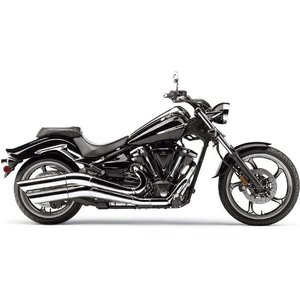Yamaha XV 1900 Raider (2008-2017): A Chopper-Inspired Powerhouse That Defies Expectations
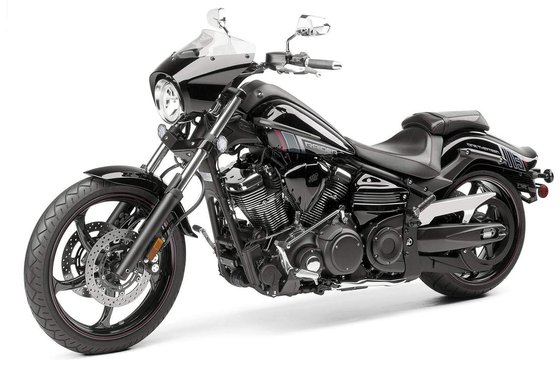
Introduction
The Yamaha XV 1900 Raider isn’t just a motorcycle—it’s a statement. From the moment you swing a leg over its sculpted saddle, the Raider announces itself as a machine that blends outlaw aesthetics with engineering precision. Produced from 2008 to 2017, this cruiser defies the “all show, no go” stereotype often associated with chopper-inspired bikes. With a 113 cubic inch (1,854cc) V-twin heart, a radical rake angle, and tires wider than some car models, the Raider is a paradox: a factory-built custom that handles like it’s dared to. Let’s dissect why this machine remains a cult favorite among riders who crave both style and substance.
Design & Aesthetics: Where Form Meets Function
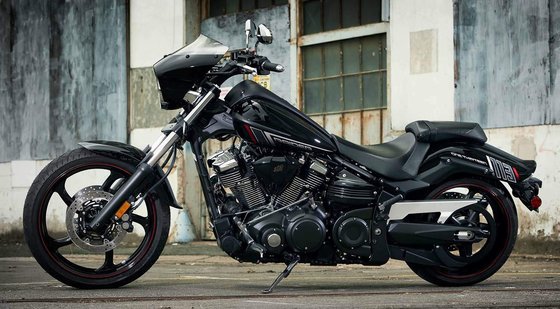
The Raider’s design is a masterclass in balancing showmanship with purpose. Its 70.9-inch wheelbase and 39-degree total rake (achieved via a 6-degree yoke offset) give it the stretched, aggressive stance of a pro-street chopper. Yet, Yamaha’s engineers refused to sacrifice usability:
- Frame: A lightweight double-cradle aluminum frame keeps mass centralized, enabling shockingly nimble handling for a 729-pound (331 kg) bike.
- Wheels: The 21-inch front and 18-inch rear wheels (wrapped in a 210/40 radial tire—the widest ever on a Star motorcycle) are pure visual theater but also enhance stability.
- Custom Touches: Models like the Raider S added chrome accents, while the Bullet Cowl variant offered a sleek, aerodynamic front fairing. Color options like Candy Red and Matte Iron/Raven ensured riders could personalize their outlaw image.
The tank-mounted analog-digital gauge cluster and hidden wiring inside the handlebars prove Yamaha sweat the small details. This isn’t a parts-bin special; it’s a cohesive design where even the cooling fins are machined to catch light like jewelry.
Engine & Performance: Torque is the Name of the Game
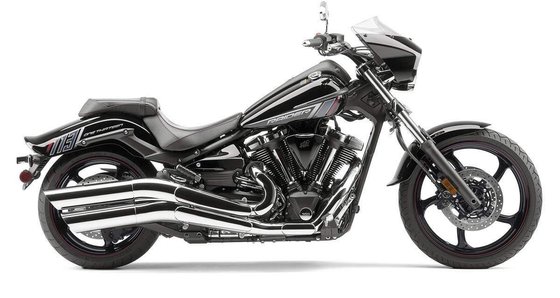
At the Raider’s core lies its air-cooled, 48-degree V-twin—a pushrod-activated beast that’s equal parts retro and high-tech. Key specs:
- Displacement: 1,854cc (113 cu-in)
- Power: 100 HP @ 4,250 RPM | Torque: 123 lb-ft (167 Nm) @ 2,500 RPM
- Fuel System: Twin-bore fuel injection with 12-hole injectors for crisp throttle response.
Riding the Raider feels like taming a muscle car. The engine’s EXUP valve (typically found on sport bikes) ensures a flat torque curve, with 90% of peak torque available just off idle. You’ll surge forward with a bass-heavy exhaust note, but vibrations stay polite thanks to dual counterbalancers.
Fuel efficiency? A claimed 42 MPG (5.6 L/100km)—remarkable for a 113 cu-in engine. The 4.2-gallon (16L) tank means 150+ mile range, though you’ll likely stop sooner to let bystanders admire the bike.
Handling & Ride Quality: The Chopper That Corners
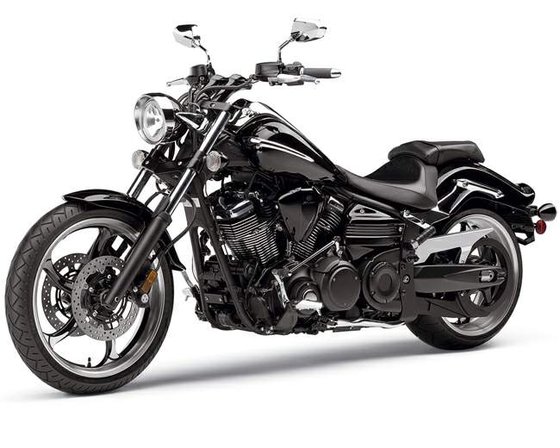
Don’t let the raked-out front end fool you—the Raider handles like a cruiser half its size. The aluminum frame and 46mm telescopic fork (5.1 inches of travel) provide precise steering, while the hidden monocross rear shock (3.5 inches of travel) soaks up bumps without wallowing.
Key dynamics:
- Weight Distribution: The low-slung engine (dry sump design) and forward foot controls create a 27.4-inch seat height, making the Raider accessible for shorter riders.
- Braking: Dual 298mm front discs with monoblock calipers offer sport-bike stopping power. The rear 310mm disc is more than adequate.
- Ergonomics: Pullback bars and a scooped seat lock you into a relaxed, feet-forward position. It’s ideal for city cruising, though the seat’s firmness might test your endurance on 3+ hour rides.
Comfort & Practicality
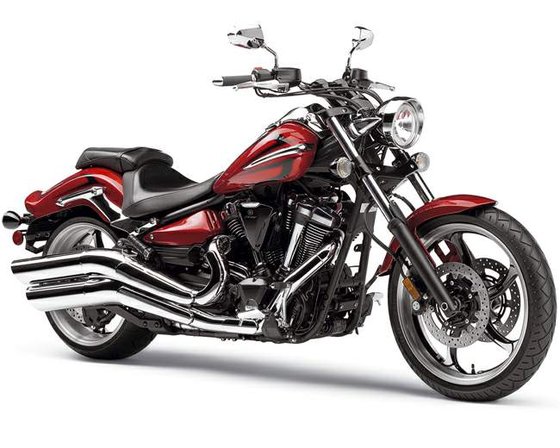
The Raider prioritizes style, but Yamaha didn’t ignore livability:
- Wind Protection: The Bullet Cowl’s fairing (optional on some models) reduces chest blast at highway speeds.
- Storage: Minimalist—this isn’t a tourer. Aftermarket saddlebags are a must for longer trips.
- Passenger Comfort: The pillion pad is an afterthought. Solo riders will revel in the bike’s focus; two-up touring demands upgrades.
Competition: How the Raider Stacks Up
The Raider’s segment included heavyweight cruisers like:
- Harley-Davidson Softail Slim
-
Similar retro styling but with a 103ci (1,690cc) engine. The Softail’s suspension is plusher, but the Raider counters with 12% more displacement and sharper handling.
-
Honda VTX1800
-
Honda’s flagship cruiser had raw power (109 lb-ft torque) but weighed 50 lbs more than the Raider. The VTX felt bulkier in corners.
-
Kawasaki Vulcan 2000
- The Vulcan’s 126ci (2,053cc) engine dwarfed the Raider’s, but its steel frame and 43.7-inch seat height made it less agile.
Verdict: The Raider carved a niche with its aluminum chassis, radical proportions, and willingness to rev. It’s the choice for riders who want chopper aesthetics without chopper compromises.
Maintenance & Ownership

The Raider is relatively low-fuss for a big cruiser:
- Belt Drive: Requires less maintenance than a chain—just inspect for debris and tension.
- Valve Adjustments: Hydraulic lifters mean 25,000-mile (40,000 km) intervals—a blessing given the pushrod design.
- Air Cooling: No radiators to worry about, but monitor engine temps in stop-and-go traffic.
Common Upgrades at MOTOPARTS.store:
- Seat: Swap the stock saddle for a plush aftermarket unit.
- Exhaust: Unleash the V-twin’s rumble with slip-on mufflers (compatible with the EXUP system).
- Handlebars: Adjustable risers let you fine-tune reach.
Conclusion: The Rebel With a Cause
The Yamaha XV 1900 Raider is a rare beast—a factory-built motorcycle that channels the rebellious spirit of custom choppers while delivering genuine performance. It’s not for everyone (baggers and tourers need not apply), but for riders who want to own the road with a mix of head-turning style and surprising agility, the Raider remains unmatched. A decade after its debut, it still feels fresh—a testament to Yamaha’s bold vision.
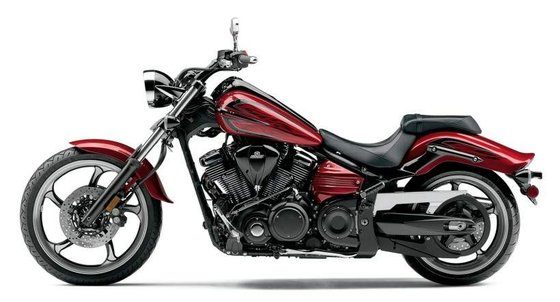
Whether you’re hunting for performance upgrades, styling tweaks, or just want to keep your Raider roaring, explore MOTOPARTS.store’s curated selection of parts designed for this iconic machine.
















Specifications sheet
| Engine | |
|---|---|
| Stroke: | Four-stroke |
| Max power: | 74 kW | 99.0 hp |
| Max torque: | 168 Nm |
| Fuel system: | Twin-Bore electronic fuel injection with throttle position sensor |
| Max power @: | 4250 rpm |
| Displacement: | 1854 ccm |
| Fuel control: | Overhead Valves (OHV) |
| Max torque @: | 2500 rpm |
| Configuration: | V |
| Cooling system: | Air |
| Compression ratio: | 9.5:1 |
| Number of cylinders: | 2 |
| Valves per cylinder: | 4 |
| Dimensions | |
|---|---|
| Wheelbase: | 1801 mm (70.9 in) |
| Dry weight: | 331 |
| Wet weight: | 340 |
| Seat height: | 696 mm (27.4 in) |
| Overall width: | 925 mm (36.4 in) |
| Overall height: | 1166 mm (45.9 in) |
| Overall length: | 2570 mm (101.2 in) |
| Ground clearance: | 145 mm (5.7 in) |
| Fuel tank capacity: | 15.9 L (4.2 US gal) |
| Drivetrain | |
|---|---|
| Belt type: | Carbon fiber reinforced |
| Final drive: | belt |
| Transmission: | 5-speed, hydraulic wet clutch |
| Maintenance | |
|---|---|
| Engine oil: | 10W40 |
| Brake fluid: | DOT 4 |
| Spark plugs: | NGK CR8E or NGK CR8EIX |
| Spark plug gap: | 0.8 |
| Forks oil capacity: | 1.2 |
| Engine oil change interval: | Every 5000 km or 2 years |
| Valve clearance (intake, cold): | 0.10–0.20 mm |
| Valve clearance check interval: | 24,000 km / 15,000 mi |
| Valve clearance (exhaust, cold): | 0.20–0.30 mm |
| Final drive belt replacement interval: | Inspect every 24,000 km |
| Performance | |
|---|---|
| CO2 emissions: | 129.9 g/km |
| Fuel consumption: | 5.6 L/100 km (42 mpg) |
| Chassis and Suspension | |
|---|---|
| Rake: | 34° |
| Frame: | Double cradle aluminum |
| Trail: | 102 mm (4.0 in) |
| Rear tire: | 210/40-18 |
| Front tire: | 120/70-21 |
| Rear brakes: | Single 310 mm disc, 1-piston caliper |
| Front brakes: | Dual 298 mm discs, 4-piston calipers |
| Rear suspension: | Link-type monoshock, 89 mm (3.5 in) travel, adjustable preload |
| Front suspension: | 46mm telescopic fork, 130 mm (5.1 in) travel |



